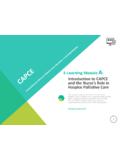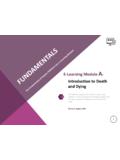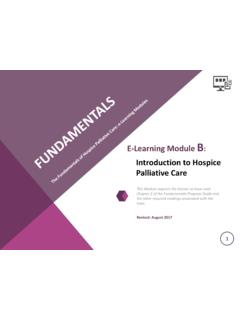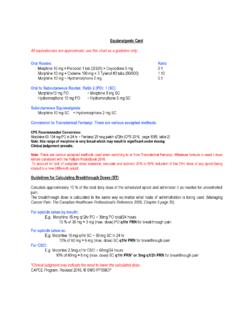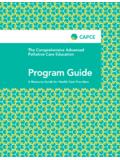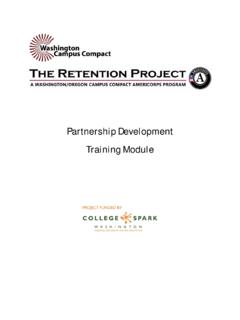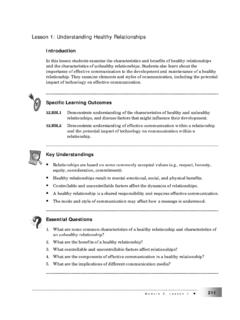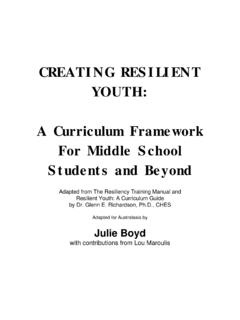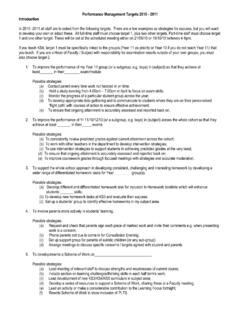Transcription of E-Learning Module Information Sharing
1 1E- learning Module C: Information Sharing This Module requires the learner to have read chapter 4 of the CAPCE Program Guide and the other required readings associated with the topic. See the CAPCE Program Guide required and recommended reading list for more : January 2017 Contents of this E-Learning Module may be reproduced in whole or in part provided the intended use is for non-commercial purposes and full acknowledgement is given to the Southwestern Ontario Hospice Palliative Care Education Program and St. Joseph s Health Care reference as follows: Southwestern Ontario Hospice Palliative Care Education Program.
2 Comprehensive Advanced Palliative Care Education E-Learning Modules. London: Southwestern Ontario Hospice Palliative Care Education Program, St. Joseph s Health Care London; 2013; second edition STARTEDThis E-Learning Module has been designed to consolidate key concepts from the required readings and provide an opportunity to begin applying these concepts through self-directed reflection and scenario-based work, in preparation for the case-based discussions, in-person, with other STARTEDIn this Module , you will review the content highlights associated with Information may be asked to write down your thoughts or ideas during this Module .
3 You can do so in the Notes section at the end of Chapter 4 in your Program Guide. Have your Program Guide with you as you complete this notes are just for you; you won t be required to submit them. However, you may be prompted to use your notes for discussion in your Peer-to-Peer Exchange and Coaching Sessions. Please be respectful of COVERED Information Sharing : Critical Concepts Effective Communication Self-Awareness in Palliative Care Conflict in Palliative Care Culture in Palliative Care Sharing Information about Diseases, Pain and Other Symptoms5 Information Sharing : CRITICAL CONCEPTSKey concepts associated with Information Sharing include: Effective communication helps build the therapeutic relationship Conflict is common in palliative care and must be managed.
4 Culturally sensitive care is driven by person-centered and self-aware. Knowledge related to disease, pain and other symptoms is critical for Information Sharing that supports informed decision COMMUNICATIONE ffective Information Sharing , through effective communication, enables effective health care decision-making by the person and order to make informed choices, the person (or substitute decision maker) needs a clear understanding of the disease and treatment being offered, including: Prognosis Treatment options Potential benefits/risks/side effects and burdens of each treatment offered Likely consequences of not receiving treatment Alternative courses of action7 EFFECTIVE COMMUNICATIONThe art of effective communication involves: Gentle truth telling Understanding that silence is a form of communication Active listening Self-awareness In your Notes section, list other techniques you typically use, or considerations you take, when communicating with the person.
5 For example, how you position your body, how you arrange the environment, COMMUNICATION No one is a perfect communicator. What strategies would you like to begin using more often? Less often? List them and explain why. For example, Eye contact sometimes makes me uncomfortable. I think I could use eye contact more effectively in silence to actively listen in a non-verbal way .9 EFFECTIVE COMMUNICATIONC ommunication needs are different between the person and family. For Example, the person may have a need to disclose feelings.
6 The family may need permission to speak. How else might the communication needs of the person differ from those of the family? Be specific and write your answer in the Notes COMMUNICATIONS ilence is a valuable communication tool and doesn t always mean that the conversation has person often needs time to process overwhelming thoughts and feelings and put them into silence allows the person to organize his order thoughts and consider a response. 11 EFFECTIVE COMMUNICATION How do you feel when in silence with the person or family?
7 How can you prompt yourself to utilize silence more effectively?12 EFFECTIVE COMMUNICATIONA ctive listening includes hearingthe person s message, understandingthe meaning of the message and then providing feedback about what was heard. What barriers can challenge your ability to engage in active listening in your workplace? How do you overcome them, or compromise? 13 EFFECTIVE COMMUNICATION How does a response sound if you are engaging in active listening? For example, So if I understand what you have just said, you feel that.
8 Provide three examples of a response that demonstrates active listening. Be prepared to use these in your next Case-Based learning IN PALLIATIVE CARETo best facilitate Information Sharing , you must explore and understand your own cultural norms and instinctive responses to conflict, as well as your personal management knowledge will allow you to anticipate, moderate and adjust your approach to therapeutic IN PALLIATIVE CAREC onflict is inevitable, and particularly complex in hospice palliative care. Brainstorm a brief list in your notes of the emotionally-laden issues that come with living with a life-limiting illness and may compound conflict.
9 For example, varying views about the meaning of quality of life .16 CONFLICT IN PALLIATIVE CARENot all conflict is harmful or your notes to identify when conflict can have positive outcomes. If you have experienced a conflict that resulted in a positive change for the person and family, briefly cause of the it was managed, outcomeUse these notes to share the experience with your partner(s) at your next peer-to-peer IN PALLIATIVE CAREThe RNAO recommends engaging in the reflective activities below to help develop self-awareness related to conflict.
10 Identify the following in your own behaviours or attitudes that may contribute to creating or escalating own conflict management style ( accommodating, avoiding, collaborating, competing or compromising) conflict resolution skills you feel you currently conflict resolution skills you would like to IN PALLIATIVE CARE Capture your answers to the following questions in your Notes: How do you like to receive feedback? What do you do when you are angry? What motivates you? What do you do to understand someone else s behaviour?
